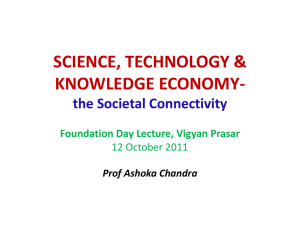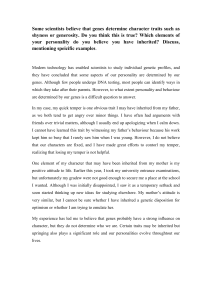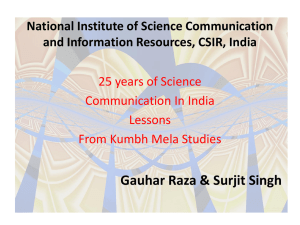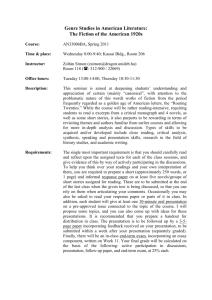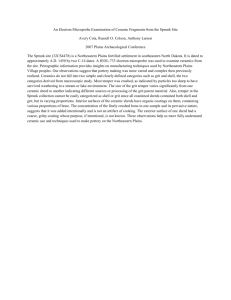Science Communication: A Conceptual Framework
advertisement
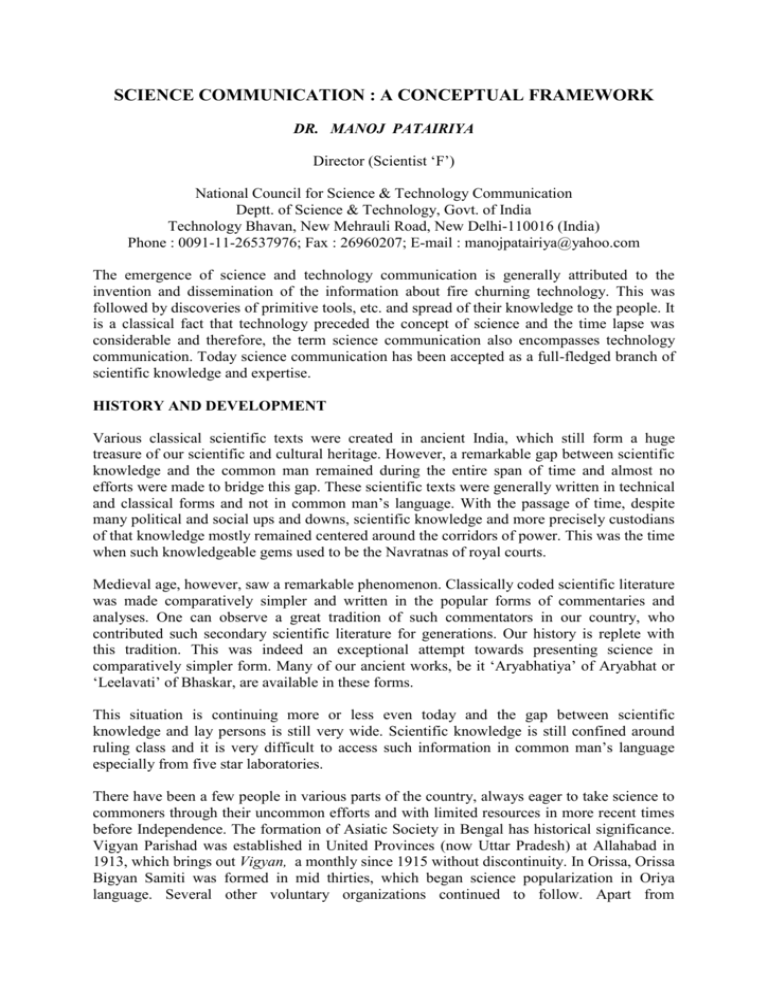
SCIENCE COMMUNICATION : A CONCEPTUAL FRAMEWORK DR. MANOJ PATAIRIYA Director (Scientist ‘F’) National Council for Science & Technology Communication Deptt. of Science & Technology, Govt. of India Technology Bhavan, New Mehrauli Road, New Delhi-110016 (India) Phone : 0091-11-26537976; Fax : 26960207; E-mail : manojpatairiya@yahoo.com The emergence of science and technology communication is generally attributed to the invention and dissemination of the information about fire churning technology. This was followed by discoveries of primitive tools, etc. and spread of their knowledge to the people. It is a classical fact that technology preceded the concept of science and the time lapse was considerable and therefore, the term science communication also encompasses technology communication. Today science communication has been accepted as a full-fledged branch of scientific knowledge and expertise. HISTORY AND DEVELOPMENT Various classical scientific texts were created in ancient India, which still form a huge treasure of our scientific and cultural heritage. However, a remarkable gap between scientific knowledge and the common man remained during the entire span of time and almost no efforts were made to bridge this gap. These scientific texts were generally written in technical and classical forms and not in common man’s language. With the passage of time, despite many political and social ups and downs, scientific knowledge and more precisely custodians of that knowledge mostly remained centered around the corridors of power. This was the time when such knowledgeable gems used to be the Navratnas of royal courts. Medieval age, however, saw a remarkable phenomenon. Classically coded scientific literature was made comparatively simpler and written in the popular forms of commentaries and analyses. One can observe a great tradition of such commentators in our country, who contributed such secondary scientific literature for generations. Our history is replete with this tradition. This was indeed an exceptional attempt towards presenting science in comparatively simpler form. Many of our ancient works, be it ‘Aryabhatiya’ of Aryabhat or ‘Leelavati’ of Bhaskar, are available in these forms. This situation is continuing more or less even today and the gap between scientific knowledge and lay persons is still very wide. Scientific knowledge is still confined around ruling class and it is very difficult to access such information in common man’s language especially from five star laboratories. There have been a few people in various parts of the country, always eager to take science to commoners through their uncommon efforts and with limited resources in more recent times before Independence. The formation of Asiatic Society in Bengal has historical significance. Vigyan Parishad was established in United Provinces (now Uttar Pradesh) at Allahabad in 1913, which brings out Vigyan, a monthly since 1915 without discontinuity. In Orissa, Orissa Bigyan Samiti was formed in mid thirties, which began science popularization in Oriya language. Several other voluntary organizations continued to follow. Apart from organizations, several enthusiastic individuals also joined the movement. Some of these were Sir Syeed Ahmed Khan in Aligarh, Ruchi Ram Sahni in Punjab, Swami Satyaprakash in Uttar Pradesh, Shivram Karanth in the south, Hargoo Lal at Ambala, and several others. After Independence, a number of government organizations also came forward for science popularization. Publications and Information Directorate (now National Institute of Science Communication) began publication of Vigyan Pragati, a Hindi monthly in 1952. Science Reporter (English monthly) and Science Ki Dunia (Urdu quarterly) followed this. National Research Development Corporation started Awishkar, a Hindi monthly and thereafter Invention Intelligence, an English monthly. Besides that, institutions like National Council of Educational Research and Training, Central Institute of Educational Technology, Consortium for Educational Communication, Directorate of Agricultural Information and Publication, Indian Council for Medical Research, Developmental Education Communication Unit (SAC), etc. also started spreading scientific knowledge concerning their areas of interest. Indian Institutes of Technology also began their periodicals. Thus, science communication was being taken up at various levels, at institutional as well as individual. With a view to integrate, coordinate, catalyze and support the efforts of science communication and science popularization, at micro as well as macro levels in the country, the Government of India established the National Council for Science and Technology Communication (NCSTC) in 1982 as an apex body. NCSTC began its activities in 1984. The prime objectives of NCSTC are – to popularize science amongst all the sections of the society, to inculcate scientific and technological temper amongst masses and to promote, catalyze, support and orchestrate such efforts in the country. In the year 1989, the Department of Science and Technology established an autonomous organization Vigyan Prasar, which undertook the task of mass scale development and dissemination of software for popularization of science and technology, such as TV programmes, audio cassettes, CDROMs, publications, etc. The National Council of Science Museums under the Ministry of Tourism and Culture is also contributing in this direction through setting up of science centers, science exhibitions, science fairs, science city and science museums, etc. Ministry of Environment and Forests has planned to create environmental awareness through ecology clubs in schools. All India Radio, Doordarshan, and other TV channels broadcast and telecast various science programmes. Central and state governments, Birla Group and Jawaharlal Nehru Memorial Fund have established several planetariums at various places in the country. Various other attempts towards science communication and science popularization are being made at governmental, non-governmental, voluntary, private and individual levels. INTRODUCTION Science communication can be referred to the flow of scientific information and message from its source to target audience, through some medium or mediator. Science communication can be categorized in two ways : (a) technical or research oriented science communication; and (b) popular science communication, which is also known as science popularization. Generally, scientists/technologists are well versed with the former and the challenge lies with the later. Generally, science and technology are born in laboratories, research/development centers, universities, technological institutions, etc. First hand information about such discoveries/developments comes in the form of research papers, theses and patent specifications prepared by experts preferably in a highly technical composition of texts, graphics, illustrations, photographs, tables, etc. This form is replete with scientific terminology, generslly in English. This kind of writing, publication and communication is termed as technical or research communication. Then comes popular science communication or science popularization, where scientific information, scientific thoughts and spirit of scientific temper need to be spread across the society. Except a few very honourable exceptions, generally, scientists and technologists find it difficult to communicate with common man in common man’s language. At the same time, the common man too is unable to understand the language of scientists - technical texts with technical jargon, specific to the subject area. Now, the problem is obvious, as the two are unable to communicate with each other, because both of them do not know the languages of each other. This leaves a wide gap between the two, which is growing day by day due to rapid advancements in our scientific knowledge. This gap needs to be bridged. As we know that the entire scientific developments and technological innovations are ultimately aimed at common man and affect their lives. These developments loose their significance, unless the information about these reaches to the end user, the common man. The task is really very challenging and important. It requires as many as missionaries, who have interest in science and the ability to understand, digest and assimilate the complex scientific information and then can present it in a simple, lucid and interesting manner to the masses in the language, comprehensible to them. These kinds of people are known as science communicators, science popularizers, science activists, science journalists, etc. There has been a general debate worldwide, whether a science communicator should be a master of any science or technology subject! A majority of people feel that it is not necessary, however, being a specialist in any scientific field is helpful. The real qualification is his ability to comprehend a subject and then present it in a simple and easily understandable manner. In order to develop trained manpower in the area of science communication, training/educational programmes are being offered at various levels in our country, which are catalyzed and supported by NCSTC : i) Short term courses, which are of 3 to 7 day’s duration; the participants are all science activists and enthusiasts, whether students of science at higher level or not; ii) Medium term courses, which are of two to four month’s duration; usually for those who wants to improve their science communication skills; and iii) Long term courses, which are of 1 to 2 year’s duration; run at different universities/institutions and offer post graduate degrees or diplomas in science communication. Besides, a correspondence course in science journalism of one year duration is also available. The main aim is to develop as many science communicators as possible to meet the present and future challenges and requirements. Science and technology communication is relatively a newer and emerging branch of science and technology, under which, possible techniques, ways, means, modes and media, their impacts and other related aspects concerning communication of scientific information, scientific thoughts and scientific temper to the masses are studied. The necessity of taking scientific knowledge and scientific sprit to all cross sections of the society has now been well recognized, besides S&T, R&D developments. Only then, the maximum benefits of fast growing science and technology can be derived for the betterment of the society. Scientific messages and thoughts can inculcate scientific temper and scientific thinking directly or indirectly into the minds of people, as a result of continuing science communication efforts. Most of our actions and decisions are influenced and motivated by the right kind of scientific knowledge and scientific thinking in the fast changing world. Science communication can further channalise and strengthen this phenomenon. Though, science communication, as a specific branch of knowledge and expertise, is in its infancy in India. It is one of our fundamental duties to develop scientific temper and spirit of inquiry amongst fellow citizens. Our science policy also reiterates the same thoughts and has ample provisions for promoting scientific temper. Science communication is the key to the real treasure of scientific knowledge and scientific temper, only by which the benefits of science and scientific temper could be carried to the common man, and thus the common man is benefited with the new advancements in various fields of science and technology and be able to fight against hunger, diseases, drought and social evils, like superstitions, etc., with courage and self confidence. OBJECTIVES AND IMPORTANCE The two main objectives of science communication are to impart scientific information among masses and inculcate scientific temper among them. It is now well understood that information is power. Those who have the right information at the right time, are powerful. Scientific awareness can strengthen and empower the whole societal fabric. Appropriate scientific information can be of great importance; for example, if lintel or pulses soaked in water before cooking, some 50% fuel/energy and time can be saved. This simple information can help save a lot of energy consumed in our kitchens. During Bhopal gas tragedy, if people could have used wet towel over their nose, many of them could have been saved, as the poisonous gas is soluble in water. Another example, even if they could have known about the direction of the wind and could have run in the opposite direction, they could have been saved. Most of them fell prey of the tragedy, as they ran in the same direction. Therefore, it is obvious, that scientific information and scientific temper have how much importance, not only in saving resources, but in saving lives too. SCIENTIFIC TEMPER AND METHOD OF SCIENCE Science communication and science popularization cannot only help fulfill the objectives of our constitution and science policy, it can transform the country into a self reliant, powerful and prosperous nation. Even scientific temper can help to find solutions of many conflicting situations. Moreover, scientific thinking can stop many such possibilities from raising their head. Another aspect of science communication and popularization is inculcation of scientific temper among masses. Merely acquiring scientific knowledge does not imply to have scientific temper. A scientifically qualified person may lack scientific temper; while as a contrast, even one who has not been a science student can posses scientific temper. Scientific temper reflects one’s logical, rational and analytical thinking, systematic and orderly way of his performance in all spheres of life, his reasonable behavior and conduct in the society and of course a rational decision making power. The scientific temper and method of science portray one’s overall personality, which is clearly visible through actions. Method of a science can be divided into following five steps : (1) Curiosity Curiosity or inquisitiveness forms the basic element of scientific temper and method of science. The wonderful quality of asking questions forces us to know more and more. Absence of this urge would impact negatively on ourselves and the society. (2) Collecting Information We gather information or collect data to satisfy our urge for inquisitiveness by several means, through observation, questionnairs, as well as through discussion, reading books, listening to radio, watching TV, visits to exhibitions, surfing the Internet, etc. (3) Observation and Analysis Information gathered through various means may not be in agreement with each other. Some may even be incorrect. So, analysis is essential to extract the correct information. Minute observation and analysis help achieve the pattern and trend of data derived and its interpretation. (4) Experimentation Great emphasis is laid on experimentation in science. Nothing can be accepted or denied without experimental verification. Hypothesis becomes a scientific law only when verified and repeated experimentally. The information received from any source should be verifiable by experimentation. Experimentation may not be limited to physical laboratory tests. Here, experimentation also implies other non-physical methods of experimentation, such as cross checking of information, repeated minute observations, independent studies, etc. (5) Result After experimental verification only, one can arrive at the final results, only then we can declare any hypothesis/information correct or incorrect. This is the final step in the method of science. Even then, we should be ready to revise our results in light of newer information or additional dimension of the problem or subject, in case it emerges in future. Generally, this is the procedure adopted for scientific research. That is why it is called the method of science. In our day to day decision making too we adopt this method. We do go for short cuts, sometimes, when we deliberately or ignorantly leave aside analytical and experimental steps and jump to conclusions. This is not only being unscientific, our decisions too loose rationality and logic. Scientific analysis and experimental verification would lead us to more appropriate and better results and decisions. Many similarities can be seen in method of science, practice of journalism and trials in the courts of law. A journalist gathers information about an incident. The court of law also collects information from all concerned. The information so received through different sources is then analyzed and testified and then only, an opinion is expressed, conclusion drawn, or judgment made. Scientifically informed and rationally thoughtful society can progress and develop in more coherent manner. SCIENTIFIC LITERACY AND MINIMUM SCIENCE Literacy is known as the ability to make signature, read and write workable letters, etc. Similarly, scientific literacy can be referred to minimal quantum of scientific knowledge and skills about our surroundings and ordinary day-to-day living. NCSTC has made an attempt under a project to define the minimum desirable quantum of scientific knowledge for a common man. Dr. Narender K. Sehgal, former Head, NCSTC and UNESCO's Kalinga Award recipient for 1991, has prepared a concept paper on scientific literacy for developing countries. The level of scientific awareness cannot be same for different regions, as it depends upon various factors, such as local circumstances, availability of information, awareness level of people. If minimum desirable level of scientific literacy can be quantified for a particular region/area/community, then this level can be achieved by integrating and focusing all ways and means of science popularization at a particular target. This level can further be revised, once the previous targets are achieved. This exercise can go on to further enhance the level of scientific literacy and this can be a natural process to arrive at higher realms. FIVE POINTS OF SCIENCE COMMUNICATION The process of science communication can be interwoven into five principles. Generally, when we talk about science communication, it obviously incorporates science popularization, scientific temper, technological temper and technology communication. Let us go deep into these five principles. (1) Language The very first thing to be decided about any science communication activity is its language. Generally, English is an accepted language when it comes to research or technical communication. Since the objective of popular science communication is to penetrate into local populace, only regional/local language or dialect can work effectively. Therefore, it is necessary that the communicator should have desirable command over the language through which he chooses to communicate. (2) Topic Now comes a subject topic or a thought, which is required to be communicated among people. This could belong to any of the branches of science and technology, such as chemistry, physics, engineering, biology, geology, agriculture, ecology, medicine, energy or space, etc. Besides, it can be a scientific message or thought that needs to be communicated for public. It is essential to decide about the topic for communication keeping the needs of audience in mind. It is always preferable to take up a narrow topic as specific as possible, which should be dealt with from different aspects. (3) Medium After deciding the language and contents, it is to be decided, as which medium of communication would be more appropriate and effective. The division on medium depends upon the subject undertaken and the target audience. Following mass media are prevalent : (a) Print Media : Such as newspapers, magazines, wallpapers, books, posters, folders, booklets, etc. (b) Audio/Visual Media : Mainly radio and TV, besides, films, slide shows, bioscope, etc. Folk Media : It has been a common observation, that through folk media, it is possible to achieve penetration to the segment where other media have limitations. Puppet shows, street plays, skits, stage performances, folk songs and folk dances, nautanki and other traditional means of communication belong to this category. This media is cost effective, entertaining and offers two-way communication. (c) (d) Interactive Media : Science exhibitions, science fairs, seminars, workshops, lectures, scientific tours, conferences, vigyan jathas, etc. The advantage here being man-to-man and two-way communication. (e) Digital Media : information technology has given birth to comparatively a new media, known as digital media. It includes Internet, CD-ROM, multimedia, simulations, etc. This is proving to be an effective medium and it can illustrate difficult concepts through text, audio, graphics, video, animation and simulation. It has also made science communication simpler to handicapped segments of the society. 4. Target Audience Selection of target audience has greatest significance. Since our treatment of the subject depends upon the target groups, common man, children, students, farmers, women, workers or specialists, etc. The manner of presentation, language, subject content, all depend upon our identified target audience, only then efficacy of a science communication effort can be ensured. 5. Forms of Presentation There are various forms of presentation or communication, such as science news, report, article, feature, story, play, poem, interview, discussion, lecture, documentary, docu-drama, scientoon (science +cartoon), satire, etc. Science, after weaving into above five points, can be communicated in friendlier manner. Though, there is ample scope for further development of these forms, especially for science communication and emerging science communicators may have an important role to play here. FIVE ELEMENTS OF SCIENCE COMMUNICATION Whatever be the subject, media, target group, form of presentation, language for communication, it is imperative that it contains following five elements of science communication and science popularization : (1) Scientific Contents The presence of some scientific contents or thought is a must in science communication. Science communication does not only mean to include the word ‘science’ as the contents. Generally, people tend to talk ‘about science’ and they do not talk ‘on science’. In other words, they refer some scientific term, in their communication, but are unable to explain it to the level of a common man. This can be well understood by an example. While reporting on Shanti Swaroop Bhatnagar Award for scientific research, if it is just mentioned that “such and such scientist was awarded in a magnanimous function...The chief guest said this and that …etc”. This certainly cannot be considered to be a science news. To make it a science news, for the purpose of science communication, the write up should contain information on the work done by the award winning scientist, its implications on our future, the nature of research work, its applications, etc., in a form comprehensible to lay persons. Science popularization efforts should never be devoid of scientific contents. (3) Language and Style of Presentation The language adopted should be fluid, simple and clear. Common spoken language is a good way of doing it. This makes it easy for the target group to clearly perceive what is desired to be communicated and derive enjoyment out of its understanding. (4) How and Why The very basis of method of science is ‘how and why’. Why there is a sparkle in the electric thunder? How an instrument works? These are common questions. For most effective science communication, it is essential to divide and subdivide the subject, go deeper into it and pose questions about all possible queries and answer them. This is the best way to simplify difficult science concepts and natural phenomenon. (4) Analysis Now-a-days there is a great demand and importance for factual and analytical information. Newspapers, which analyze a news item or a statement with clear analogy and present it in dynamic and vivid manner, are well accepted by the readers. Among television channels, the viewership of such channels are greater, which dissect a news with logical analysis. It is, therefore, also essential in science communication to bring in the dimensions of dynamism and awareness that such analytical features are never missed out. This trend can only be developed after deep contemplation and extensive exchange of thoughts. (5) Entertainment/Humour There is yet another essential element of science popularization. The contents need to be made interesting, so that the target group can be attracted and made to appreciate the presentation. Otherwise, they would prefer to switch over to film based entertainment programme, if it is a boring science programme on radio. It is, therefore, a prerequisite for a science popularization effort, that along with science, entertainment, humour, interesting anecdotes, etc. are amalgamated. Then only can science be made to penetrate masses and scientific thinking stimulated. Apart from humour, the topics best liked are useful and contemporary ones. For example, any information related to earthquakes would be greatly appreciated and accepted by not only affected areas but also others in the aftermath of tragedy. Authenticity greatly matters in science and so in science communication. It is better not to communicate incorrect, half-correct, information. Thus, it is necessary, that along with entertainment, usefulness, clarity, authenticity and timeliness be not thrown on sidelines. These five elements emerged out of various experiments by the author during his pursuits in science communication. These, however, may not find agreement with every science communicator. It is for them to further this hypothesis on the basis of their own experiences. This process is bound to elevate science communication efforts to newer heights. CONVERGING GAPS Here is an interesting example – a professor in biotechnology, once bluntly asked during a science communication programme, that he is coordinating a popular lecture scheme related to subjects on biotechnology for students and other interested people. But his concern was that majority of the audience cannot sit through the entire lecture and they prefer to leave the lecture in middle. He was not happy with this and wanted to know what should be done to avoid this in future. I simply asked him as how different were these lectures from the ones given in his classes? There were almost none. Here lies the difference. I tried to convince him about the need to talk to his audience in common man’s language, instead of talking in technical classroom language, along with interesting incidents and examples, coupled with slides and models and involving the audience with him. The secret lies in creating audience's involvement by encouraging questions and providing their explanation in an interesting manner. This requires tremendous communicative efforts. He then finally picked up the necessary strings from here and was extremely pleased and appreciative in the next meeting. He even went a step further in his endeavour. He arranged his presentations (not lecture) in out of school environment, organized visits to subject related places, factories, research laboratories, botanical gardens, etc, which he found to have created a very positive impact. This example establishes enough that interesting manner of presentation amalgamated with entertainment and lucidity is essential for effective science communication, be it popular science writing, audio/video programmes, folk performance or any other form of popular science communication. In fact, now these elements are even being emphasized in regular education curriculum. GREY SCIENCE COMMUNICATION Grey invariably refers to sub standard, unlawful, undisciplined, unorganized or any other similar reference. Science communication is not totally devoid of this unwelcome practice. There are plethoras of magazines, newsletters, house journals, etc. being published in the name of science. Many of these are not even registered with the Registrar of Newspapers of India (RNI). The print line is not properly published, even the date of publication is unclear. This is probably due to lack to awareness about press laws and publishing of periodicals. The irony of such publications is that though their declared objective is to take science to common man, but generally, these are confined to their writers, contributors and select individuals, who matters in the particular field. They have not to face competition in the open market. Extra-scientific contents find enough space in these. Sometime, the authenticity of the scientific information contained can be questioned. Some of such publications are printed on costly glossy paper and full of multicoloured photographs, which are extreme expands of uncontrolled misuse of resources. These harm the reputation of the organization though they claim just opposite. It is pity that not only private organizations, but also some public institutions are involved in such unethical practice. Numerous such publications in Hindi and regional languages also, leave their objectives far behind. Likewise many programs/activities on science communication are organized by various institutions on various occasions, including science exhibitions, workshops, seminars, etc. On many occasions, it is difficult to differentiate whether it is a seminar or a workshop; it is the Chief Guest speaking first or the Chairman. Science exhibitions, several times, exhibit previously displayed models; for example, a solar powered tube light, which actually operated by a hidden battery. What is intended to be achieved through all this? We need to carefully examine all these, and then only will it be possible to carry forward the most essential task of science popularization in right earnest. DIMENSIONS Addressing the delegates from south Asian nations at a recently held UNESCO workshop in Chandigarh, Shri Anuj Sinha, Head, NCSTC opened yet another aspect of science communication, he said "the experts from different fields usually exchange information amongst those in the same field. There is an emergent need for their such exchanges with common people and experts from other fields". Prof. V.S. Ramamurthy, Secretary, Department of Science & Technology, while commenting upon science communication programmes, said "people shocked by an earthquake ask whether they should go back to their houses or not? Similarly their question about genetically modified transgenic fruits is, whether such fruits can be safely consumed? It is difficult to answer these in simple terms. Science communication efforts are required to empower the people and make them capable to analyze and weigh different aspects of the problem against available information and take most appropriate decisions. This is yet another aspect, which can best be addressed through science communication efforts”. Our readers would have many more experiences to choose from their interaction with experts and common people. We welcome these aspects which may further contribute to developing a more comprehensive approach to science and technology communication. Like any other branch of science and technology, science communication is an extremely interesting area consisting of several branches, sub branches and narrower subjects offering challenges to go deeper into these, explore, develop and strengthen them.

